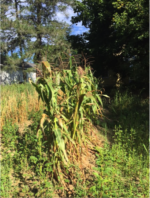In 2015, I ordered both Baxter Sweet and Abenaki Rose heritage corns from Groundswell Farm in Embden, ME and planted it in my 100 year old father-in-law’s garden. The garden area had been over-used, but I side dressed the hills of corn occasionally and the corn production was weak. The Baxter Sweet is intended to be eaten as corn on the cob, but I missed the optimal harvest time, so I picked the pathetic ears of both varieties after much of the plant had dried. In 2016, I planted some more Abenaki Rose. This time, I took the soil more seriously, had it tested, and applied more organic fertilizer. I kept the rows well weeded, side dressed the rows monthly with more organic fertilizer , and the output was better.

At the end of both growing season, I waited until the stalks dried and removed ears from the two small rows of corn, shucked them, and continued to dry the exposed cobs in my critter-free attic. Once dry, I needed to get those tough little kernels off the cob. Getting the kernels off the cob bare-handed was tough, but wearing rubberized gardening gloves or using a floppy jar opener did the trick. I had nearly a gallon-sized bag of kernels to grind both seasons. Isn’t the Abenaki Rose beautiful?
Now to grind it. Being frugal, I tried pounding the kernels with a hammer. This would have taken approximately the entire winter to complete. Research on line showed me that I could buy a grinder for $25 (my kind of price) that, according to reviews, would most certainly break on its first use. A more guaranteed type of mill cost about $250 (not my kind of price). But my beloved Kitchen Aid mixer offers a mill for just over $100. I could nearly rationalize the purchase because of the quality of my Kitchen Aid and foreseeing a potential in milling future harvests of corn and grain. I ground the kernels on a coarser grind and then again at a finer level.
We enjoyed the cornmeal in 2015 and the second growing in 2016. I loved the pretty flecks of pink from the Abenaki Rose. Although I’ve used the cornmeal for coating, polenta, and other recipes, I return to cornbread and Johnny Cakes often. The Johnny Cakes can either be a thin batter that looks like lace as it cooks and is delicious and crispy. A more standard, pancake-like Johnny Cake is simply made with a thicker batter. The cornbread is very fragrant and delicious as well, though disappointing in the disappearance of the pink flecks.

Not only have we enjoyed the earth to table adventure, growing flint corn has taken on a deeper meaning, a history lesson that I have learned through Maine Grain Alliance. We live on the Kennebec River and an archeological dig a few years ago discovered Native American Indian artifacts. How interesting and humbling to be able to produce the corn and food items that are such a part of our local heritage.



